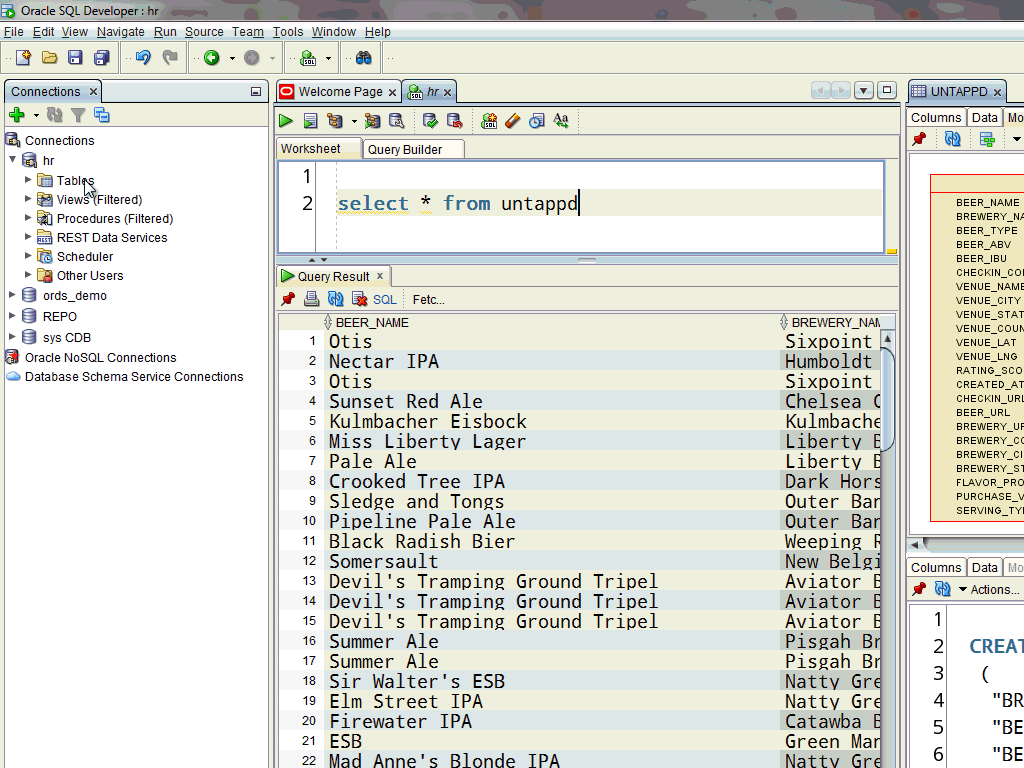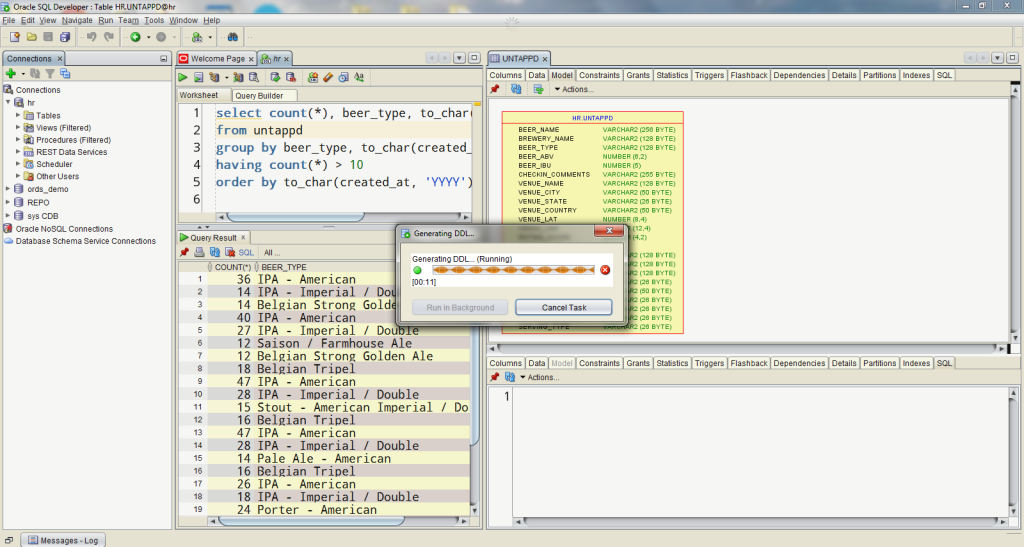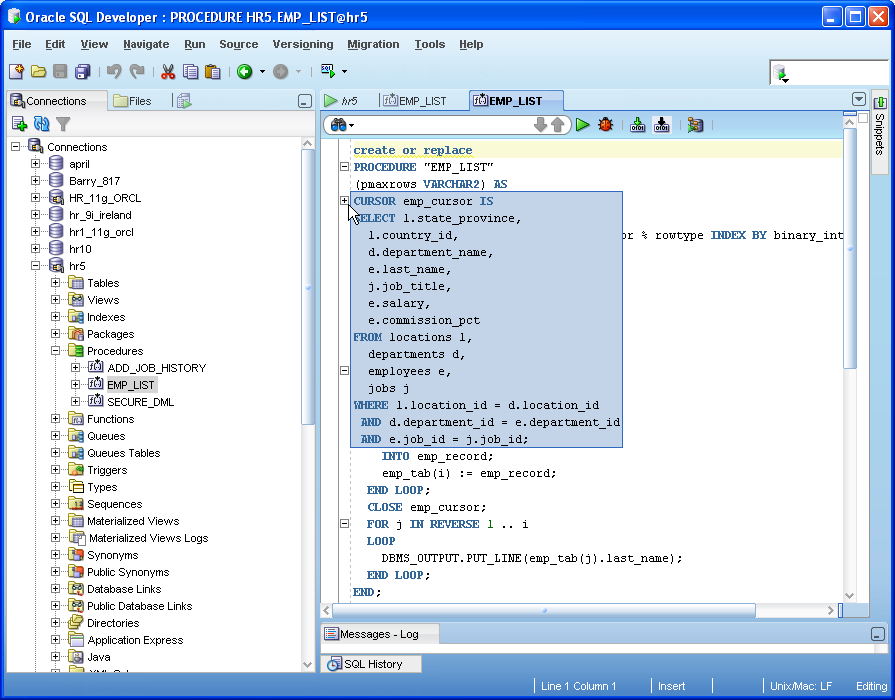If that doesn't suit you, our users have ranked 25 alternatives to PL/SQL Developer and 16 are available for Mac so hopefully you can find a suitable replacement. Other interesting Mac alternatives to PL/SQL Developer are DataGrip (Paid), Oracle SQL Developer (Free), SQuirreL SQL (Free, Open Source) and Toad for Oracle (Paid). SQLDeveloper for Mac belongs to Developer Tools. The actual developer of this free Mac application is Oracle. The most popular versions among SQLDeveloper for Mac users are 3.1 and 1.1. Ed is London, UK based Sql Server and.Net developer who has a worked for almost 15 years in a mixture of support, development and database administration. Ed is passionate about Sql Server development and loves using tools such as tSQLt, Sql Server Data Tools, DacFx Api and ScriptDom to deliver automated and testable solutions.
Are you missing the feature to record and playback a macro in SQL-Developer?
Well, it's there, just a bit hidden!
[Update: If you use SQL Developer version 4.01 or newer please read this post: Using macros – Update for version 4.01 ++]
Activate the macro functions
- Select 'Tools/Preferences' from the main menu.
- Select 'Shortcut Keys' in the list on the left.
- Enter 'macro' the right search field.
- Assign 'Ctrl+Period' to 'Macro Playback'. Period is the '.' key on your keyboard.
- Assign 'Ctrl+Shift+Period' to 'Macro Toggle Recording'.
Record a macro
To start the recording of the macro, use an editor window of SQL-Developer and press the keys control (ctrl), shift and period (.) together.
The status bar on the bottom shows 'Keystroke recording started.'
Any key you will press from now on will be recorded for replay through this macro.
When you are done press the keys control (ctrl), shift and period (.) together again.
The status bar on the bottom shows 'Keystroke recording ended.'
There is only one drawback: You can only have one macro at a time. When you record a new macro the previous macro is gone!

Use the macro
Just press the keys control (ctrl) and period (.) together and your macro gets played back.
Example

Sql Developer For Mac Download
Adding quotes and commas to a list
Ever wanted the get rid of manually adding quotes and commas to a list of strings?
With a macro it is easy to get from this:
Item 01
Item 02
Item 03
…
Item 99
to this:
‘Item 01',
‘Item 02',
‘Item 03',
…
‘Item 99',
Here is how:
- Go to the first line of the list.
- Start the recording by pressing the keys control (ctrl), shift and period (.) together.
- Press the following keys (pos1) (‘) (end) (‘) (,) and ('arrow down') one after each other.
- End the recording by pressing the keys control (ctrl), shift and period (.) together again.
- Play back the macro by pressing the keys control (ctrl) and period (.) together.
- Repeat step 5 until the list is done.
- Written by: ilmarkerm
- Category: Blog entry
- Published:
One part of setting up my new laptop was also setting up SQL Developer WITH Oracle Driver, because a year or two ago I rolled out radius authentication for all users who need to access the production databases directly and radius (and other non-default-password authentication schemes) do not work with thin JDBC driver. Being new to Macworld and not finding any guides for this task online, it was quite a struggle in the beginning. Here I'm trying to share my experiences if anybody else find themselves in the similar situation. If you find any mistakes here, please let me know – I'm new to the world of MacOS 🙂
Sql Developer Osx
Jan Karremans just today published a similar article about Mac and Instant client, but the goal of my blog post is to get SQL Developer connected through Instant Client.
JDK
First you need Java installed, I installed 64-bit JDK8, but it would be better to install 64-bit JDK7, since SQL Developer 4.0 is not supported on JDK8.
Sql Developer For Macbook Pro
SQL Developer
When I'm writing this, SQL Developer 4.1 is in Early Adopter release and 4.0 is in production. I installed SQL Developer 4.0.3.

Oracle Instant Client
There is another reason to choose SQL Developer 4.0 over 4.1 – 4.1 requires version 12.1 of the Oracle Client and that is not yet released for MacOS. SQL Developer 4.0 requires Oracle Client 11.2.0.3 and that is available for MacOS. I downloaded Instant Client 11.2.0.3 (64-bit – since I installed 64-bit JDK): instantclient-basic-macos.x64-11.2.0.3.0.zip and instantclient-sqlplus-macos.x64-11.2.0.3.0.zip to be precise. I unzipped both these files under /opt so my Instant Client installation directory is /opt/instantclient_11_2. After unzipping, Instant Client installation instructions require creating the following symlinks:
Configuring SQL Developer
Open SQL Developer, open Preferences and go to Database > Advanced. Configure Oracle Client paths and check Use Oracle Client and Use OCI/Thick driver boxes. Here is the sample screenshot from my settings.
When you press the Configure button to set the Oracle client path, there is also a button to Test if the Client was loaded correctly. Currently this test should fail.
Setting the environment variables
We need to set two environment variables: DYLD_LIBRARY_PATH to make sure applications can find and load the instant client libraries and TNS_ADMIN so instant client could find sqlnet.ora and tnsnames.ora files. In my case sqlnet.ora is essential, since I need to use Radius authentication.
First I added these environment variables to ~/.profile:
After restarting terminal and verifying that these environment variables are indeed set, execute SQL Developer app directly from terminal by executing open /Applications/SQLDeveloper.app/.
Open preferences and press the Oracle Client Test button again, now the test should succeed and SQL Developer is connected through Instant Client.
All good! Great success! Guess again… Close SQL Developer and launch it from Docker/Launchpad and you will see the Oracle Client test failing again. This is because the environment variables under ~/.profile or ~/.bash_profile are loaded only inside Terminal.

Use the macro
Just press the keys control (ctrl) and period (.) together and your macro gets played back.
Example
Sql Developer For Mac Download
Adding quotes and commas to a list
Ever wanted the get rid of manually adding quotes and commas to a list of strings?
With a macro it is easy to get from this:
Item 01
Item 02
Item 03
…
Item 99
to this:
‘Item 01',
‘Item 02',
‘Item 03',
…
‘Item 99',
Here is how:
- Go to the first line of the list.
- Start the recording by pressing the keys control (ctrl), shift and period (.) together.
- Press the following keys (pos1) (‘) (end) (‘) (,) and ('arrow down') one after each other.
- End the recording by pressing the keys control (ctrl), shift and period (.) together again.
- Play back the macro by pressing the keys control (ctrl) and period (.) together.
- Repeat step 5 until the list is done.
- Written by: ilmarkerm
- Category: Blog entry
- Published:
One part of setting up my new laptop was also setting up SQL Developer WITH Oracle Driver, because a year or two ago I rolled out radius authentication for all users who need to access the production databases directly and radius (and other non-default-password authentication schemes) do not work with thin JDBC driver. Being new to Macworld and not finding any guides for this task online, it was quite a struggle in the beginning. Here I'm trying to share my experiences if anybody else find themselves in the similar situation. If you find any mistakes here, please let me know – I'm new to the world of MacOS 🙂
Sql Developer Osx
Jan Karremans just today published a similar article about Mac and Instant client, but the goal of my blog post is to get SQL Developer connected through Instant Client.
JDK
First you need Java installed, I installed 64-bit JDK8, but it would be better to install 64-bit JDK7, since SQL Developer 4.0 is not supported on JDK8.
Sql Developer For Macbook Pro
SQL Developer
When I'm writing this, SQL Developer 4.1 is in Early Adopter release and 4.0 is in production. I installed SQL Developer 4.0.3.
Oracle Instant Client
There is another reason to choose SQL Developer 4.0 over 4.1 – 4.1 requires version 12.1 of the Oracle Client and that is not yet released for MacOS. SQL Developer 4.0 requires Oracle Client 11.2.0.3 and that is available for MacOS. I downloaded Instant Client 11.2.0.3 (64-bit – since I installed 64-bit JDK): instantclient-basic-macos.x64-11.2.0.3.0.zip and instantclient-sqlplus-macos.x64-11.2.0.3.0.zip to be precise. I unzipped both these files under /opt so my Instant Client installation directory is /opt/instantclient_11_2. After unzipping, Instant Client installation instructions require creating the following symlinks:
Configuring SQL Developer
Open SQL Developer, open Preferences and go to Database > Advanced. Configure Oracle Client paths and check Use Oracle Client and Use OCI/Thick driver boxes. Here is the sample screenshot from my settings.
When you press the Configure button to set the Oracle client path, there is also a button to Test if the Client was loaded correctly. Currently this test should fail.Setting the environment variables
We need to set two environment variables: DYLD_LIBRARY_PATH to make sure applications can find and load the instant client libraries and TNS_ADMIN so instant client could find sqlnet.ora and tnsnames.ora files. In my case sqlnet.ora is essential, since I need to use Radius authentication.
First I added these environment variables to ~/.profile:
After restarting terminal and verifying that these environment variables are indeed set, execute SQL Developer app directly from terminal by executing open /Applications/SQLDeveloper.app/.
Open preferences and press the Oracle Client Test button again, now the test should succeed and SQL Developer is connected through Instant Client.
All good! Great success! Guess again… Close SQL Developer and launch it from Docker/Launchpad and you will see the Oracle Client test failing again. This is because the environment variables under ~/.profile or ~/.bash_profile are loaded only inside Terminal.Setting environment variables on login
This seems to be the most complex part of this story since it seems to change with every MacOS release. The method that is working for me under Yosemite (and in no way am I declaring that it is the best method, I am a Mac newbie after all), is this:
Open application Script Editor and paste the following AppleScript there:
Yes, it is also necessary to set TNS_ADMIN, since setting the TNS admin directory path under SQL Developer preferences does not work if you need to use specific settings in sqlnet.ora, for example authentication.
Save the script and in the save dialog set File format: Application. And finally System settings -> Users & Groups -> Login items press + sign and select the application you just saved. Now, log out from MacOS and log back in. Now SQL Developer should work with Instant Client even when you launch it from Launchpad.
Sql Developer For Mac
I got this method from a Stackoverflow thread.
